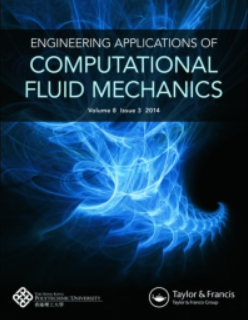Aerodynamic impact of wind-sand flow on moving trains in tunnel-embankment transition section: from field testing to CFD modeling
IF 5.9
1区 工程技术
Q1 ENGINEERING, MECHANICAL
Engineering Applications of Computational Fluid Mechanics
Pub Date : 2023-11-14
DOI:10.1080/19942060.2023.2279993
引用次数: 0
Abstract
The acceleration of land desertification has led to an increasingly serious threat to the operation safety of tunnel entrance in the Gobi and desert regions by wind-sand flow, and it is urgent to study and enhance the running safety of train. Firstly, an ultrasonic anemometer is used to collect the characteristics of wind-sand flow at a tunnel entrance site in Xinjiang, China. Then, based on the Euler multiphase flow and the SST k-w model, the variation difference law of the train running at the tunnel entrance is revealed under the four inflow conditions of constant crosswind, constant wind-sand flow, pulsating crosswind and pulsating wind-sand flow respectively. Finally, the disturbance law of the solid wind barrier at the tunnel entrance on the wind-sand flow and the influence mechanism on the train’s flow field structure and pressure are revealed. The results show that compared with other cases, the pulsating wind-sand flow has the most significant effect on the moving trains’ aerodynamic loads (ALs), and the sand particles carried in the air cause the trains’ ALs to fluctuate within 9.09%. The solid wind barrier has a significant disturbing effect on the wind-sand flow, and the lightweight sand particles follow the air flow over the top of the wind barrier and are not deposited on the embankment during a short period, and the wind-sand flow’s impact on the HSTs is dramatically reduced. The wind barrier changes the HST’s flow field, and the AL fluctuation of the train is sharply reduced. The maximum values of the head train’s AL coefficients are reduced by 46.53–85.75%.风沙流对隧道-路堤过渡段行驶列车的气动影响:从现场试验到CFD建模
土地沙漠化的加速导致戈壁沙漠地区风沙流对隧道入口运行安全的威胁日益严重,研究和提高列车运行安全已迫在眉睫。首先,利用超声波风速仪对新疆某隧道入口风沙流特征进行了采集。然后,基于欧拉多相流和SST k-w模型,分别揭示了恒定侧风、恒定风沙流、脉动侧风和脉动风沙流4种入流条件下隧道入口处运行列车的变化差规律。最后,揭示了隧道入口固体风障对风沙流的扰动规律以及对列车流场结构和压力的影响机理。结果表明:与其他情况相比,脉动风沙流对运行列车气动载荷的影响最为显著,空气中携带的沙粒使列车气动载荷波动幅度在9.09%以内;固体风障对风沙流有明显的干扰作用,轻质沙粒随风障顶部的气流在短时间内不沉积在路基上,风沙流对路基的影响显著减小。风障改变了高速列车的流场,列车的AL波动明显减小。首列AL系数最大值减小46.53 ~ 85.75%。
本文章由计算机程序翻译,如有差异,请以英文原文为准。
求助全文
约1分钟内获得全文
求助全文
来源期刊

Engineering Applications of Computational Fluid Mechanics
ENGINEERING, MULTIDISCIPLINARY-ENGINEERING, MECHANICAL
CiteScore
10.60
自引率
14.80%
发文量
109
审稿时长
3.4 months
期刊介绍:
The aim of Engineering Applications of Computational Fluid Mechanics is a continuous and timely dissemination of innovative, practical and industrial applications of computational techniques to solve the whole range of hitherto intractable fluid mechanics problems. The journal is a truly interdisciplinary forum and publishes original contributions on the latest advances in numerical methods in fluid mechanics and their applications to various engineering fields including aeronautic, civil, environmental, hydraulic and mechanical. The journal has a distinctive and balanced international contribution, with emphasis on papers addressing practical problem-solving by means of robust numerical techniques to generate precise flow prediction and optimum design, and those fostering the thorough understanding of the physics of fluid motion. It is an open access journal.
 求助内容:
求助内容: 应助结果提醒方式:
应助结果提醒方式:


